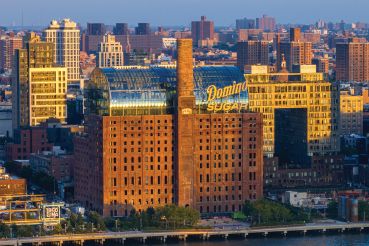<i>Daily News</i>’s 4 New York Plaza Offices Could Be Uninhabitable for a Year
By Al Barbarino November 8, 2012 3:31 pm
reprintsMr. Zuckerman would later engage in a friendly sparring match with Larry Silverstein over the prospects for the city and country’s direction. Mr. Zuckerman took a highly pessimistic tone, but not before making his position on the support he received in the aftermath of the storm clear: “We come out of it with gratitude to be part of the New York City community, which is still in my judgment the most generous and the most supportive community,” he said.
Mr. Silverstein said his buildings were relatively unaffected by the storm, including those in and around the World Trade Center site. But he chimed in with a piece of advice when discussion turned to the rebuilding effort and the future of New York City development.
“One of the lessons we learned from 9/11 is that a good place to put generators is not down at the bottom, it’s at the top,” he said, adding that all current and future Silverstein Properties construction will place mechanical equipment and generators on high floors.
The road to recovery will likely be a long one. As of yesterday, 44 of 183 Class A and Class B buildings remained closed in Lower Manhattan, according to the latest data from Jones Lang LaSalle, accounting for 32.8 percent of the total 101,175,754 square feet of inventory.
“We have to use our talents and be creative in coming up with ideas,” said William Rudin, chief executive of Rudin Management Company and the moderator of the first of three panels at today’s event, which also included Mr. LeFrak and Jeff Blau of Related Companies.
“Bear in mind, there’s a new normal … we designed for an 11-foot surge and now there are 13- and 14-foot surges, and they could go higher,” said Mr. Rudin, who is chairman of the Association for a Better New York, adding that Mr. Blau, who said his buildings did not suffer significant damage, had called him to offer support.
“We have vacant land in the boroughs that we can offer to the city, the state, the federal government for interim housing short-term relief—so that’s going on,” Blau said. “With Richard, Jeff Gural [chairman of Newmark Grubb Knight Frank] opened up the Meadowlands to Red Cross workers who cooked thousands of meals.”
Mr. Blau said his company has been working with the Department of Housing Development and Preservation and the city to create a log of available units and ultimately provide them as affordable housing to displaced residents.
The Related Companies is also working with FEMA to potentially provide 600,000 square feet of retail at the Gateway Center in Brooklyn for housing purposes. Mr. Zuckerman added that, despite its troubles, the Daily News had raised hundreds of thousands of dollars” for those displaced by the storm.
Meanwhile, despite widespread damages to Mr. LeFrak’s portfolio of buildings in New Jersey and New York, his battalion of plumbers, electricians, building managers and a variety of other employees snapped into action in an effort that helped restore the assets and make them habitable for residential tenants living in his buildings.
“We have about 40 high-rise buildings that were affected by the flood, probably 7,000 residential units and close to 5 million square feet of office space that was part of the surge,” Mr. LeFrak said.
“Because we have a big inventory of housing, and because I can mobilize an army in about an hour, I was able to actually restore all my properties within four days and relocate about 150 tenants who lived on ground-floor apartments that were uninhabitable, and basically provide hot water, electricity and heat,” he added.


